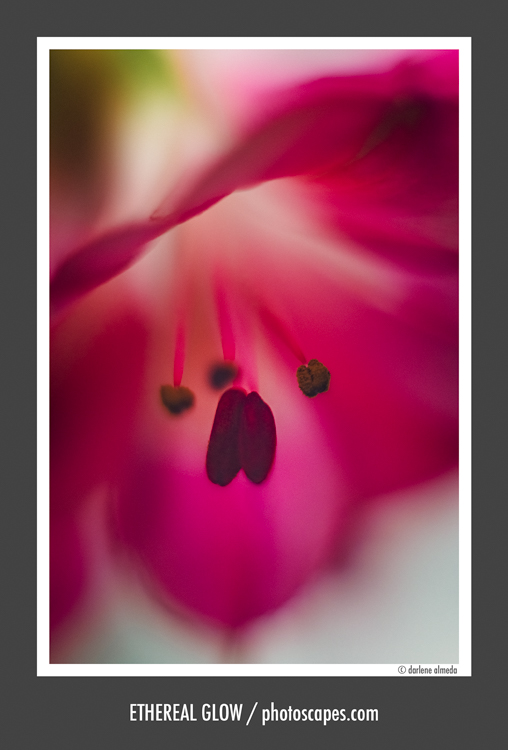Camera: Fujifilm X-Pro2 Lens: Fujifilm XF 56/1.2 R APD Digital: 24 MP [24×16] CMOS Software: Adobe Lightroom
Location: Studio Date: November 2017 Lighting: Profoto D1 500 Other: MCEX 11 & 16 Tubes
Have you ever considered what extension tubes can do for your photography? In this behind-the-lens post, I’ll share an image I created using two stacked extension tubes and a lens typically suited for portrait work.
Flowers, with their vibrant colors and delicate fragrance, are among my top five favorite subjects to photograph. While I also enjoy capturing other types of still life, flowers often inspire me to get up close—really close. For creative photography, I sometimes aim for greater-than-life-size details, and to achieve this, I rely on extension (or macro) tubes and teleconverters.
The terms “extension tubes” and “macro tubes” are often used interchangeably. The difference lies in their emphasis: macro tubes highlight their primary use in macro photography, while extension tubes describe their technical function—extending the lens farther from the sensor. Regardless of the label, both tools let you focus closer, unlocking detailed and intimate perspectives in your photography.
The flower in Ethereal Glow came from a store-bought bouquet at a Publix grocery store here in North Florida. I often buy these bouquets—not just to brighten up my table but also as inspiration for photography. There are times during the year when I can’t escape with my camper van as much as I’d like for some landscape photography and adventure. When cabin fever strikes, I head to my local Publix or dig into my collection of seashells and found objects, always seeking something beautiful to capture through my lens.
If I’m in the mood for a flower that’s a bit different, I’ll drive farther into town to visit Trader Joe’s. Their flower selection tends to be more varied—at least at my location—but I’ve noticed that their flowers don’t last as long as those from Publix. I like to let flowers sit for a day or two before photographing them. I’m also drawn to blooms some might call “over-ripe.” There’s something about waiting those extra days—the colors seem more vibrant to my eyes. While others may see fading petals, I see an opportunity to capture a unique beauty that speaks of depth and character.
This image was photographed in my studio using a Profoto D1 500 strobe. The bouquet was arranged in a vase and placed on my product table. I used my Fujifilm X-Pro2 camera, equipped with an “L” bracket and a SmallRig Wooden Side Handle. The handle plays a crucial role in my workflow, letting me move freely in and out of the bouquet while adjusting focus as needed with the Fujifilm XF 56/1.2 R APD lens set @ f/1.2, combined with the MCEX 11mm and 16mm extension tubes (27mm total extension). The handle provides a secure grip, making it far more comfortable to maneuver and focus precisely for close-up shots like this.
When working with extension tubes—especially stacked ones—the plane of focus can be razor-thin. I’ve found that moving in and out (with my feet), letting the lens guide me to the focal plane, works best. For this type of photography, I’m not interested in using a view camera or a rail system. Having spent hundreds of hours on those setups for product photography, I prefer a more relaxed approach for this type of art. This is for fun—a reason to pick up a beautiful bouquet, search for the art within, and call it a day. This is when I see my studio as a playroom! 🙂
This process, however, takes time and patience. I often shoot numerous frames to capture just a handful where the focus lands exactly as I envision. There’s no focus stacking involved—every image is a single-shot capture. I intentionally avoid stacking because I want the natural bokeh and out-of-focus areas to contribute to the artistic feel of the image. Ethereal Glow exemplifies this approach with its delicate interplay between sharp focus and soft, dreamy blur, creating an evocative and unique visual experience.
My lens of choice for achieving this aesthetic is the Fujifilm XF 56mm f/1.2 R APD. Its apodization filter is specifically designed to enhance the quality of out-of-focus areas, making it ideal for selective focus applications. As a bokeh enthusiast, this lens perfectly aligns with my vision. While I can’t compare it to the non-APD version—I’ve never used that one—I’ve found complete satisfaction with the APD version, which continues to inspire my creative journey.
I hope you’ve enjoyed this behind-the-lens look at an image I consider both beautiful and rewarding to create.

